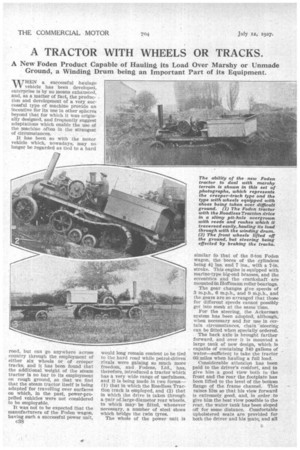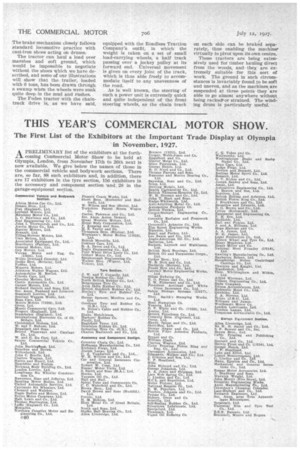A TRACTOR WITH WHEELS OR TRACKS.
Page 60

Page 61

Page 62

If you've noticed an error in this article please click here to report it so we can fix it.
A New Foden Product Capable of Hauling its Load Over Marshy or Unmade Ground, a Winding Drum being an Important Part of its Equipment.
WTHENa successful haulage vehicle has been developed, enterprise is by no means exhausted, and, as a matter of fact, the production and development of a very sacce.s.sful type of machine provide an incentive for its use in other spheres beyond that for which it was originally designed, and frequently suggest adaptations which enable the use of the machine often in the strangest of circumstances.
It has been so with the motor vehicle which, nowadays, may no longer be regarded as tied to a hard road, but can go anywhere across country through the employment of either six wheels or of creeper tracks, and it has been found that the additional weight of the steam tractor is no bar to its employment on rough ground, so that we find that the steam tractor itself is being adapted for travelling over surfaces on which, in the past, power-propelled vehicles were not considered to be employable.
It was not to he expected that the manufacturers of the Foden wagon, having such a successful power unit, c38
would long remain content to be tied to the hard road while petrol-driven rivals were gaining so much more freedom, and Fodens, Ltd., has, therefore, introduced a tractor which has a very wide range of usefulness, and it is being made in two forms--(1) that in which the Roadless Traction track is employed, and (2) that in which the drive is taken through a pair of large-diameter rear wheels, to which maybe fitted, whenever necessary, a number of steel shoes which bridge the twin tyres.
The whole of the power unit is similar fo that of the 6-ton Foden wagon, the bores of the cylinders being 4,1ins, and 7 ins., with a 7-in. stroke. This engine is equipped with marine-type big-end brasses, and the eccentrics and the crankshaft are mounted in Hoffmann roller bearings.
The gear changes give speeds of 3 m.p.h., 6 m.p.h., and 9 m.p.h., and the gears are so arranged that those for different speeds cannot possibly get into mesh at the same time.
For the steering, the Ackerman system has been adopted, although, when necessary and for use in certain circumstances, chain 'steering can be fitted When specially ordered.
The back axle is brought farther forward, and over it is mounted a large tank of new design, which is capable of containing 340 gallons of water--sufficient to take the tractor 60: miles when hauling a full load.
Considerable attention has been paid to the driver's corafort, and to give him a good view both to the front and the rear the footplate has been lifted to the level of the bottom flange of the frame channel. This raises Him so that his view forward is extremely good, and, in order to give him the best view possible to the rear, the water tank has been sloped off for some distance. Comfortable upholstered seats are provided for both the driver and his mate, and all controls have been placed within easy reach of their positions.
On each side of the tank, as will be seen from our photographs, a large toolbox is fitted.
The machine has called, of course, for an entirely new rear axle equipped with a winding drum. The axle is driven by a single chain, and it is equipped with driving wheels 5 ft. in diameter, the size of the twin tyres being 1,374 min. by 180 mm. section. These wheels are fitted with camoperated brakes, the drums of which are 3 ft. 6 ins, in diameter.
The steel shoes to which we have referred are 12 in number And are made to withstand very heavy duty. They bridge over both tyres and each is held by a central stud passing between the two tyres and through the wheel rim, which is screwed up to bosses cast on the inside of the wheel rim. They are thus quite easily fitted, and often it occurs that just the fitting of one or two will serve to enable the vehicle to extricate itself from an extremely difficult position.
To revert to the winding drum on the back axle, this consists of a large cast-steel ring made in halves, fixed to the compensating centre and running on a bearing on the rear axle. A loose slip drum runs on the ring to carry the wire rope, and this may be connected to the steel ring by placing a driving pin in a pair of holes provided on the two castings. The advantage of the slip drum is that the wire rope can be led out quickly. frOm the dram to the object to be hauled, without the need for running the engine.
This Winding drum has a capacity of 100 yards of i-in, diameter rope and it revolves at the same speed as the road wheels would do, according to the gear which may be engaged, as, of course, any of the three gears can be employed when winding operations are being undertaken, the speed of winding depending upon the conditions prevailing and upon the Load carried on the trailer. The winding rope is led out from the winding drum over a hori
zontal roller guide and between two guides disposed vertically, these being fixed to the pulling bar at the rear.
A. large brake ring is -cast on the slip drum and this, in addition to its purpose a braking the slip drum when required, acts as a compensating-centre brake for the tractor when the machine is running on the road. This brake works simultaneously with the usual hand-brake drum, thus forming a double brake, both brakes being operated by a single screw and nut in the driver's cab.
The brake mechanism closely follows standard locomotive practice with cast-iron shoes acting on drums.
The tractor can haul a load over marshes and soft ground, which would be impossible to negotiate without the shoes which we have described, and some of our illustrations will show that the trailer, loaded with 6 tons, has been drawn through a swamp what the wheels were sunk quite deep in the mud and rushes.
The Foden tractor with the chaintrack drive is, as we have said, equipped with the Roadless Traction Company's outfit, in which the weight is taken on a set of small load-carrying wheels, a half track passing over a jockey pulley at its forward end. Universal movement is given on every joint of the track, which is thus able freely to accommodate itself to any unevenness of the road.
As is well known, the steering of such a power unit is extremely quick and quite independent of the front steering wheels, as the chain track on each side can be braked separately, thus enabling the machine' virtually to pivot upon its own centre.
These tractors are being extensively used for timber hauling direct from the woods, and they are extremely suitable for this sort of work. The ground in such circumstances is invariably found to be soft and uneven, and as the machines are suspended at three points they are able to go almost anywhere without being rackeclkor strained. The winding drum is particularly useful.












































































































